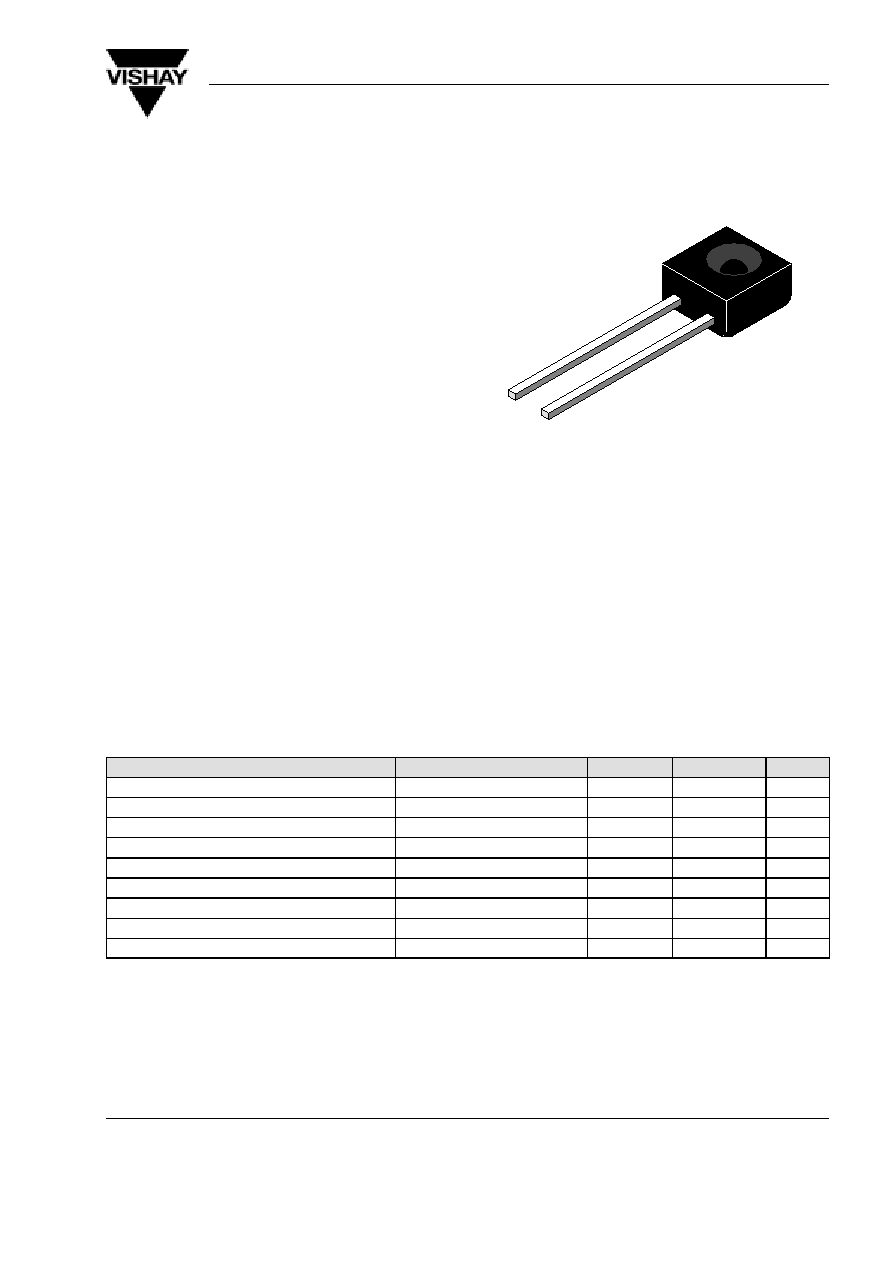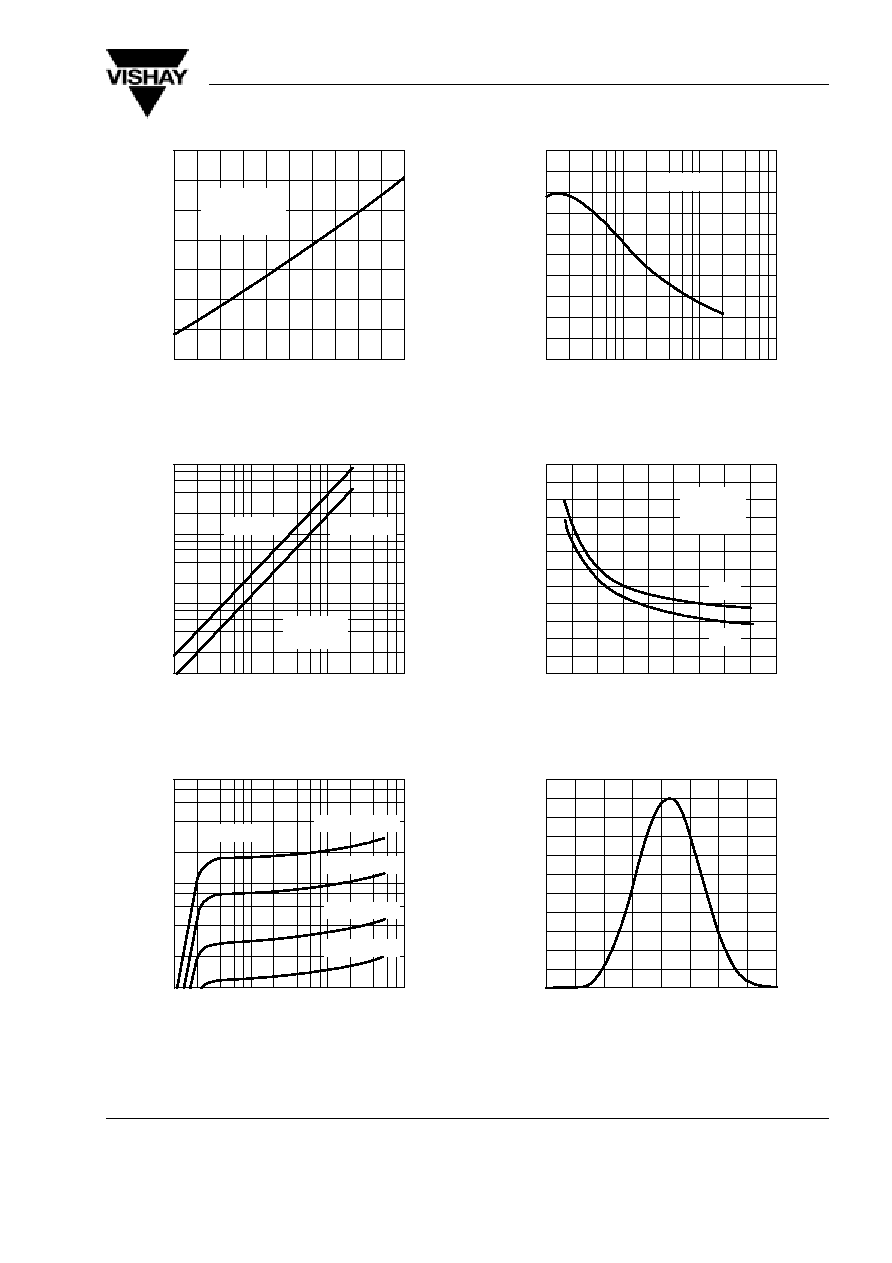Äîêóìåíòàöèÿ è îïèñàíèÿ www.docs.chipfind.ru

BPW78
Vishay Telefunken
1 (5)
Rev. 2, 20-May-99
www.vishay.de
·
FaxBack +1-408-970-5600
Document Number 81528
Silicon NPN Phototransistor
Description
BPW78 is a high sensitive silicon NPN epitaxial planar
phototransistor in a flat side view plastic package.
A small recessed lens provides a high sensitivity in a
low profile case.
The epoxy package itself is an IR filter, spectrally
matched to GaAs or GaAs on GaAlAs IR emitters
(
l
p
> 850nm).
Features
D
Plastic case with IR filter
D
Suitable for near infrared radiation
D
High radiant sensitivity
D
Super flat sideview case with spherical lens
D
Lens integrated
D
Irradiation direction vertical to mounting direction
D
Angle of half sensitivity
=
±
25
°
D
Selected into sensitivity groups
D
Compatibel with CQX48
94 8487
Applications
Detector in electronic control and drive circuits
Absolute Maximum Ratings
T
amb
= 25
_
C
Parameter
Test Conditions
Symbol
Value
Unit
Collector Emitter Voltage
V
CEO
32
V
Emitter Collector Voltage
V
ECO
5
V
Collector Current
I
C
100
mA
Peak Collector Current
t
p
/T = 0.5, t
p
x
10 ms
I
CM
200
mA
Total Power Dissipation
T
amb
x
40
°
C
P
tot
150
mW
Junction Temperature
T
j
100
°
C
Storage Temperature Range
T
stg
55...+100
°
C
Soldering Temperature
t
x
5 s
T
sd
260
°
C
Thermal Resistance Junction/Ambient
R
thJA
400
K/W

BPW78
Vishay Telefunken
2 (5)
Rev. 2, 20-May-99
www.vishay.de
·
FaxBack +1-408-970-5600
Document Number 81528
Basic Characteristics
T
amb
= 25
_
C
Parameter
Test Conditions
Symbol
Min
Typ
Max
Unit
Collector Emitter Breakdown
Voltage
I
C
= 1 mA
V
(BR)CE
O
32
V
Emitter Collector Breakdown
Voltage
I
E
= 100
m
A
V
(BR)EC
O
5
V
Collector Dark Current
V
CE
= 20 V, E = 0
I
CEO
1
100
nA
Collector Emitter Capacitance
V
CE
= 5 V, f = 1 MHz, E = 0
C
CEO
6
pF
Angle of Half Sensitivity
±
25
deg
Wavelength of Peak Sensitivity
l
p
920
nm
Range of Spectral Bandwidth
l
0.5
850...980
nm
Collector Emitter Saturation
Voltage
E
e
= 1 mW/cm
2
,
l
= 950 nm, I
C
= 0.1 mA
V
CEsat
0.3
V
TurnOn Time
V
S
= 5 V, I
C
= 5 mA,
R
L
= 100
W
t
on
6
m
s
TurnOff Time
V
S
= 5 V, I
C
= 5 mA,
R
L
= 100
W
t
off
5
m
s
CutOff Frequency
V
S
= 5 V, I
C
= 5 mA,
R
L
= 100
W
f
c
110
kHz
Type Dedicated Characteristics
T
amb
= 25
_
C
Parameter
Test Conditions
Type
Symbol
Min
Typ
Max
Unit
Collector Light Current V
CE
=5 V,
E =1 mW/cm
2
BPW78A
I
ca
1
2
3
mA
E
e
=1 mW/cm
2
,
l
p
=950 nm
BPW78B
I
ca
2
4
mA
Typical Characteristics (T
amb
= 25
_
C unless otherwise specified)
0
20
40
60
80
0
40
80
120
160
200
P
T
otal Power Dissipation ( mW
)
tot
T
amb
Ambient Temperature (
°
C )
100
94 8259
R
thJA
Figure 1. Total Power Dissipation vs.
Ambient Temperature
94 8249
20
I Collector Dark Current ( nA
)
CEO
100
40
60
80
T
amb
Ambient Temperature (
°
C )
10
0
10
1
10
2
10
3
10
4
V
CE
= 10V
Figure 2. Collector Dark Current vs. Ambient Temperature

BPW78
Vishay Telefunken
3 (5)
Rev. 2, 20-May-99
www.vishay.de
·
FaxBack +1-408-970-5600
Document Number 81528
94 8239
0
0.6
0.8
1.0
1.2
1.4
2.0
I Relative Collector Current
ca rel
20
40
60
80
T
amb
Ambient Temperature (
°
C )
100
1.6
1.8
V
CE
=5V
E
e
=1mW/cm
2
l=950nm
Figure 3. Relative Collector Current vs.
Ambient Temperature
0.01
0.1
1
0.01
0.1
1
10
I Collector Light Current ( mA
)
ca
E
e
Irradiance ( mW / cm
2
)
10
94 8251
V
CE
=5V
l=950nm
BPW 78 A
BPW 78 B
Figure 4. Relative Radiant Sensitivity vs.
Angular Displacement
0.1
1
10
0.1
1
10
I Collector Light Current ( mA
)
ca
V
CE
Collector Emitter Voltage ( V )
100
94 8252
E
e
=1 mW/cm
2
l=950nm
0.5 mW/cm
2
0.2 mW/cm
2
0.1 mW/cm
2
Figure 5. Collector Light Current vs.
Collector Emitter Voltage
0.1
1
10
0
4
8
12
16
20
C Collector Emitter Capacitance ( pF )
CEO
V
CE
Collector Emitter Voltage ( V )
100
94 8247
f=1MHz
Figure 6. Collector Emitter Capacitance vs.
Collector Emitter Voltage
0
4
8
12
16
94 8253
0
2
4
6
8
12
t / t
T
urn on /
T
urn
of
f
T
ime ( s )
of
f
I
C
Collector Current ( mA )
10
m
on
V
CE
=5V
R
L
=100
W
l=950nm
t
off
t
on
Figure 7. Turn On/Turn Off Time vs. Collector Current
700
800
900
1000
1100
94 8270
0
0.2
0.4
0.6
0.8
1.0
S ( ) Relative Spectral Sensitivity
rel
l Wavelength ( nm )
l
Figure 8. Relative Spectral Sensitivity vs. Wavelength

BPW78
Vishay Telefunken
4 (5)
Rev. 2, 20-May-99
www.vishay.de
·
FaxBack +1-408-970-5600
Document Number 81528
0.4
0.2
0
0.2
0.4
S Relative Sensitivity
rel
0.6
94 8254
0.6
0.9
0.8
0
°
30
°
10
°
20
°
40
°
50
°
60
°
70
°
80
°
0.7
1.0
Figure 9. Relative Radiant Sensitivity vs.
Angular Displacement
Dimensions in mm
96 12193

BPW78
Vishay Telefunken
5 (5)
Rev. 2, 20-May-99
www.vishay.de
·
FaxBack +1-408-970-5600
Document Number 81528
Ozone Depleting Substances Policy Statement
It is the policy of Vishay Semiconductor GmbH to
1. Meet all present and future national and international statutory requirements.
2. Regularly and continuously improve the performance of our products, processes, distribution and operating
systems with respect to their impact on the health and safety of our employees and the public, as well as their
impact on the environment.
It is particular concern to control or eliminate releases of those substances into the atmosphere which are known as
ozone depleting substances ( ODSs ).
The Montreal Protocol ( 1987 ) and its London Amendments ( 1990 ) intend to severely restrict the use of ODSs and
forbid their use within the next ten years. Various national and international initiatives are pressing for an earlier ban
on these substances.
Vishay Semiconductor GmbH has been able to use its policy of continuous improvements to eliminate the use of
ODSs listed in the following documents.
1. Annex A, B and list of transitional substances of the Montreal Protocol and the London Amendments respectively
2 . Class I and II ozone depleting substances in the Clean Air Act Amendments of 1990 by the Environmental
Protection Agency ( EPA ) in the USA
3. Council Decision 88/540/EEC and 91/690/EEC Annex A, B and C ( transitional substances ) respectively.
Vishay Semiconductor GmbH can certify that our semiconductors are not manufactured with ozone depleting
substances and do not contain such substances.
We reserve the right to make changes to improve technical design and may do so without further notice.
Parameters can vary in different applications. All operating parameters must be validated for each customer application
by the customer. Should the buyer use Vishay-Telefunken products for any unintended or unauthorized application, the
buyer shall indemnify Vishay-Telefunken against all claims, costs, damages, and expenses, arising out of, directly or
indirectly, any claim of personal damage, injury or death associated with such unintended or unauthorized use.
Vishay Semiconductor GmbH, P.O.B. 3535, D-74025 Heilbronn, Germany
Telephone: 49 ( 0 ) 7131 67 2831, Fax number: 49 ( 0 ) 7131 67 2423




